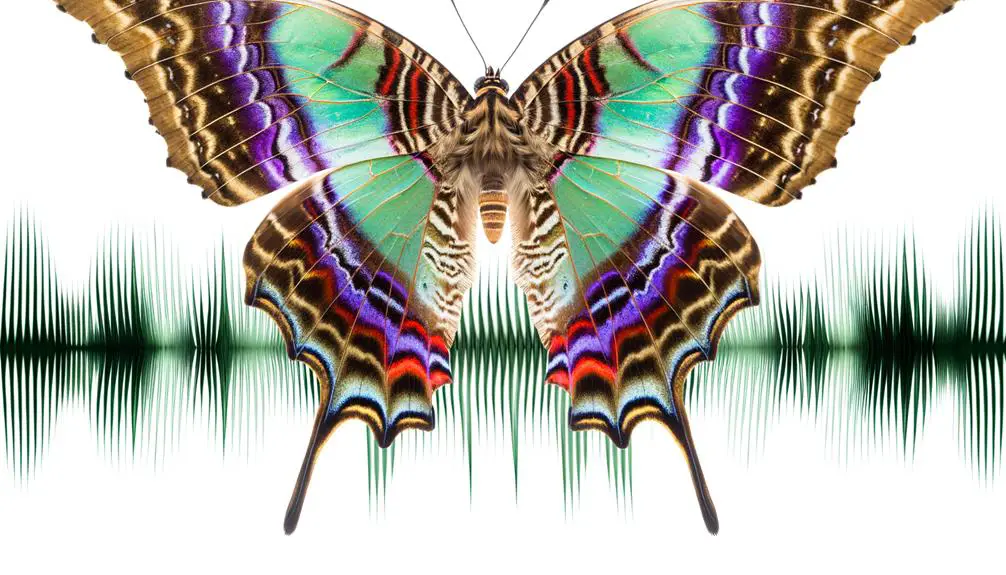What Sound Does a Butterfly Make?
Butterflies are not silent; they produce sounds via mechanical means such as wing stridulation and rapid wing movements. Certain species, like Hamadryas feronia, generate audible clicks during territorial disputes by clapping their wings, while others like Morpho rhetenor emit whistling noises in flight using specialized scales.
These sounds typically result from the interaction of wing membranes with air or frictional vibrations between body parts, as butterflies lack vocal cords. Additionally, sounds aid in predator avoidance, communication, and mating.
Detailed empirical studies highlight these fascinating acoustic behaviors and their ecological significance, offering deeper insights into butterfly biology.

Key Takeaways
- Some butterflies, like the Cracker butterfly, produce audible clicking sounds through wing clapping.
- Butterflies generate sounds through stridulation, rubbing body parts together to create frictional vibrations.
- Larger butterflies produce lower sounds due to slower wingbeat frequencies, while smaller ones generate higher-pitched sounds.
- Specific species, such as Morpho rhetenor, create whistling noises in flight using specialized scales.
Butterfly Anatomy and Sound

Butterflies, despite their delicate appearance, possess a complex anatomy that includes specialized structures capable of producing and perceiving sound.
The tympanal organs, located on the abdomen, are vital for auditory perception, allowing butterflies to detect specific frequencies of sound. These membranous structures vibrate in response to acoustic waves, converting them into neural signals.
Additionally, certain species utilize stridulation, a mechanism involving the rubbing of body parts, such as wings or legs, to generate sound. This process involves microscopic ridges and comb-like structures that create frictional vibrations.
Research has demonstrated that these auditory capabilities are essential for predator avoidance and environmental navigation. Consequently, the intricate anatomical features of butterflies underscore their sophisticated sensory and communication systems.
How Butterflies Communicate
Through a combination of visual signals, chemical cues, and auditory mechanisms, butterflies employ a multifaceted approach to communication that promotes mate attraction, territorial disputes, and predator deterrence. Visual signals, such as wing coloration and patterns, are critical for species and mate recognition. Chemical cues, primarily pheromones, convey information about reproductive status and territory. Auditory communication, though less common, involves low-frequency sounds produced by wing or body movements. These sophisticated methods guarantee effective interaction within diverse environments.
| Communication Mode | Mechanism | Example |
|---|---|---|
| Visual | Wing coloration | Bright patterns to attract mates |
| Chemical | Pheromones | Scents to mark territory or attract mates |
| Auditory | Low-frequency sounds | Sounds to deter predators or signal presence |
These methods exemplify the complexity of butterfly communication.
Wing Movement and Noise

Wing movement in butterflies is characterized by a specific wingbeat frequency that varies among species, influencing the acoustic emissions produced.
Detailed analysis reveals that these frequencies can range from 5 to 20 Hz, contributing to the nuanced soundscapes in their habitats.
The mechanism of sound production involves the interaction of wing membranes with surrounding air, resulting in species-specific auditory signatures.
Wingbeat Frequency Analysis
How does the frequency of wingbeats correlate with the acoustic properties of the noise produced by butterfly wings?
Butterfly wingbeat frequencies typically range between 5 to 20 Hz, depending on species and environmental conditions. This low-frequency oscillation results in subtle, often near-inaudible sounds.
Detailed observations indicate that larger butterflies, such as the Monarch, exhibit slower wingbeat frequencies, producing lower frequency noise. Conversely, smaller butterflies, like the Common Blue, demonstrate higher wingbeat frequencies, generating slightly higher-pitched sounds.
Empirical studies using high-sensitivity microphones reveal that the amplitude and frequency of the wingbeats influence the magnitude and pitch of the resultant noise.
Hence, wingbeat frequency is a critical parameter in determining the acoustic signature of butterfly movement, underscoring the nuanced relationship between biomechanics and sound production.
Sound Production Mechanism
Leveraging biomechanical analysis, the sound production mechanism in butterflies is primarily attributed to the rapid movement of their wings, which displaces air and generates characteristic acoustic signals. The frequency and intensity of these sounds are contingent on wing morphology and the speed of wingbeats.
| Parameter | Observation |
|---|---|
| Wingbeat Frequency | Ranges between 5 and 20 Hz, depending on species |
| Wing Morphology | Thicker, more robust wings produce louder sounds |
| Displacement Volume | Greater wing surface area displaces more air, enhancing sound production |
| Acoustic Measurement | Sounds typically range from 30 to 60 dB |
| Species Variability | Variations in sound patterns are observed among different butterfly species |
These sounds, though often faint, play roles in communication, predator deterrence, and mating rituals. Evidence indicates that specific wing movements can generate unique acoustic signatures, enhancing interspecies and intraspecies interactions.
Do Butterflies Have Vocal Cords?
Butterflies lack vocal cords, as their anatomical structure does not include a larynx or any equivalent organ.
Instead, sound production in butterflies, if present, is primarily facilitated through mechanical means, such as wing movements and stridulation.
Detailed observations and anatomical studies reveal that the butterfly throat is devoid of any specialized structures for vocalization, underscoring the reliance on alternative mechanisms for sound generation.
Anatomy of Butterfly Throat
Contrary to common belief, butterflies do not possess vocal cords or a throat anatomy capable of producing sounds through vocalization. The butterfly's anatomy is markedly different from that of vertebrates, featuring an exoskeleton and lacking complex internal structures like vocal cords. Instead, their respiratory system consists of a network of tracheae and spiracles, facilitating gas exchange without sound production.
| Feature | Butterflies | Vertebrates |
|---|---|---|
| Vocal Cords | Absent | Present |
| Throat Structure | Simple | Complex |
| Respiratory Mechanism | Tracheae and Spiracles | Lungs and Trachea |
| Sound Production | None | Vocalization |
| Primary Sound Source | Wing Movement | Vocal Cords/Throat |
Understanding these distinctions is essential for comprehending how butterflies interact with their environment.
Sound Production Mechanism
Given the absence of vocal cords in butterflies, their sound production is primarily facilitated through alternative mechanisms such as wing movements and other physical interactions.
Detailed observations and studies reveal that these insects produce sounds primarily via three methods:
- Stridulation: This involves the rubbing of body parts together to produce sound, similar to the mechanism observed in crickets.
- Wing Clapping: The rapid movement and clapping of wings can generate audible clicks or rustling sounds.
- Tymbal Structures: Some species possess specialized structures that can be vibrated to create sound waves.
These evidence-based findings indicate that while butterflies lack conventional vocal apparatus, they employ a variety of sophisticated physical techniques to produce and communicate through sound.
Sound Detection in Butterflies

Recent studies have revealed that butterflies possess specialized auditory organs, known as tympanal membranes, that enable them to detect and respond to sound frequencies in their environment.
These tympanal membranes are typically located at the base of the wings and are sensitive to a range of acoustic signals.
Research indicates that these structures can discern low-frequency sounds, potentially aiding in predator avoidance.
For instance, the ability to detect the echolocation calls of bats provides a significant survival advantage.
Detailed observations have shown that butterflies exhibit evasive maneuvers upon sensing such ultrasonic frequencies.
This evidence-based understanding underscores the complexity of butterfly sensory systems and highlights their evolutionary adaptations for survival in acoustically diverse habitats. Additionally, researchers have discovered that the butterfly sense of smell plays a crucial role in locating food sources and identifying suitable mates. This olfactory ability, combined with their auditory and visual adaptations, allows butterflies to navigate complex environments with remarkable efficiency. By integrating multiple sensory inputs, butterflies optimize their chances of survival and reproduction in diverse ecological settings.
Species That Make Sounds
Certain butterfly species have been documented to produce sounds through mechanisms such as wing stridulation and other specialized structures. These acoustic signals are primarily used for intraspecific communication and predator deterrence.
Notable examples include:
- Hamadryas feronia: Utilizes wing clapping to create a clicking sound, often during territorial disputes.
- Morpho rhetenor: Possesses specialized scales on its wings that produce a whistling noise when in flight, potentially serving as a warning signal.
- Ageronia butterflies: Known for emitting ultrasonic clicks that can startle predators, enhancing their survival.
Empirical studies confirm these species' unique acoustic capabilities, contributing valuable insights into the adaptive evolution of sensory modalities in Lepidoptera.
These sounds, though subtle and often imperceptible to the human ear, play essential ecological roles.
Myths and Misconceptions

Despite the well-documented acoustic capabilities of certain butterfly species, numerous myths and misconceptions persist regarding the sounds they produce and their ecological significance.
One prevalent myth is that butterflies are entirely silent creatures. However, specific species such as the Cracker butterfly (Hamadryas) are known to produce audible clicks.
Another misconception is that these sounds are primarily used for predator deterrence. While acoustic signals can serve as a defense mechanism, evidence suggests they also play roles in mating and territorial behaviors.
Additionally, some believe that all butterflies capable of sound production use the same mechanisms, whereas studies show variation in how different species generate and utilize these sounds, reflecting their distinct ecological niches and evolutionary pathways.
Scientific Studies on Butterfly Sounds
Investigating the acoustic behaviors of butterflies, researchers have conducted numerous studies to elucidate the mechanisms and functions of sound production across various species. These studies often utilize advanced acoustic recording equipment and precise behavioral observations to capture and analyze the subtle sounds produced by butterflies.
Key findings include:
- Wing Clicks: Certain species, such as the Great Eggfly, produce clicking sounds through rapid wing movements, potentially serving as a deterrent against predators.
- Stridulation: Some butterflies, like the Blue Morpho, create sounds by rubbing body parts together, a phenomenon known as stridulation.
- Vibrational Communication: Recent evidence suggests that butterflies might use substrate-borne vibrations as a form of communication during mating.
These findings highlight the complexity and diversity of butterfly acoustic behaviors, contributing to a deeper understanding of their ecological interactions.
Observing Butterfly Behavior

Building on the insights gained from acoustic studies, observing butterfly behavior in their natural habitats offers further valuable data on their interactions, feeding patterns, and mating rituals.
Detailed field observations have revealed that butterflies exhibit complex foraging strategies, often selecting host plants based on chemical cues.
Their mating rituals, observed in species like the Monarch (Danaus plexippus), involve intricate flight patterns and pheromonal communication.
Additionally, territorial behaviors can be noted, particularly in males, who engage in aerial displays to ward off rivals.
These behaviors are often synchronous with environmental cues such as light and temperature, suggesting a high degree of ecological adaptation.
Collectively, these observations enrich our understanding of butterfly ecology and their adaptive mechanisms.
Conclusion
In the silent ballet of butterflies, the absence of vocal cords does not preclude the existence of sound.
Wing movements, while primarily for flight, can create subtle noises, a phenomenon documented in specific species through scientific studies.
These delicate sounds, often overshadowed by myths, offer a glimpse into the intricate communication methods among butterflies.
Understanding these nuances enriches the knowledge of entomological acoustics, revealing the hidden symphony within the lepidopteran world, akin to uncovering whispers in a quiet forest.






